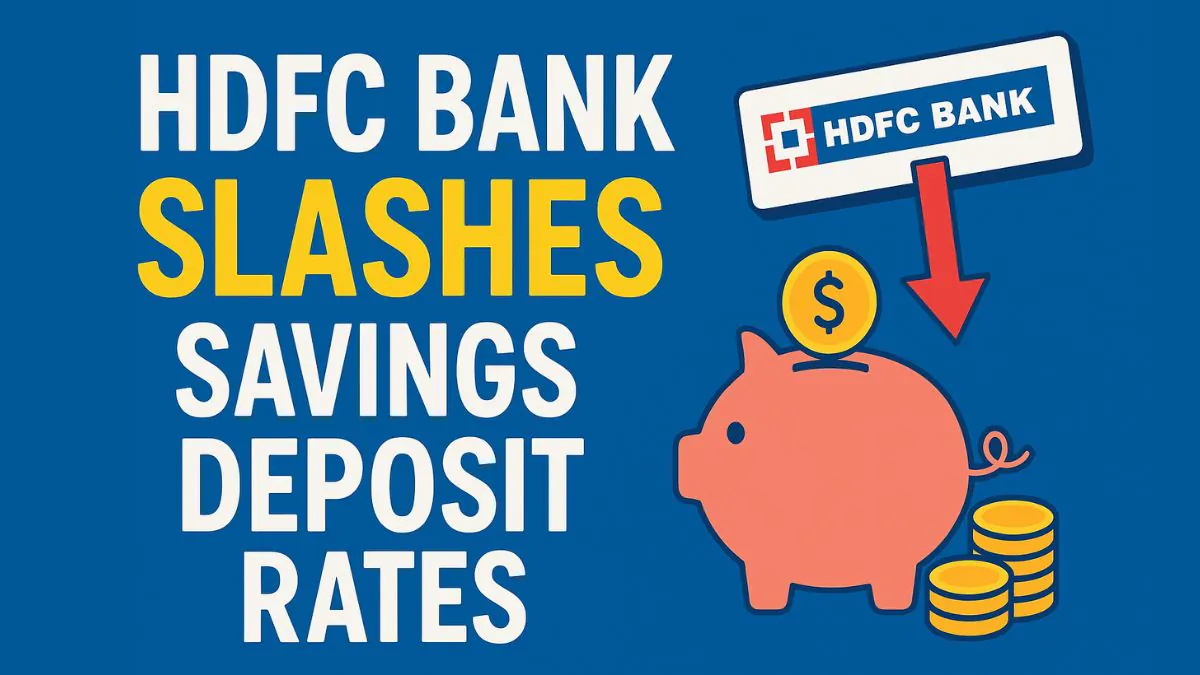HDFC Bank Reduces Savings Deposit Rates: What It Means for You

Table of Contents
ToggleShare this article ↷
HDFC Bank, one of India’s biggest private banks, recently slashed its savings deposit rates by 25 basis points, bringing the rate to 2.75% for balances below ₹50 lakh and 3.25% for higher amounts.
This is the first such cut in five years, and it’s got people talking! With loan growth slowing, the bank is trying to boost its profit margins. But what does this mean for your personal finance? Let’s break it down in simple terms and figure out how to keep your money working for you.
Read also: Indian Stock Market Update – Latest Sensex & Nifty News
What Exactly Has Changed?
The interest rate on savings account balances below ₹5 lakh has been reduced from 3.50% to 3.25% per annum. Balances above ₹5 lakh will still earn the earlier higher rate, depending on the slab. This change applies to both individual and joint savings accounts.
For most middle-class families and salaried individuals, this is a significant update. Since many rely on interest from their savings account to cover small monthly expenses, even a small reduction can impact their overall personal finance planning.
Why Did HDFC Bank Reduce the Rates?
There are a few major reasons behind this move:
Loan growth is slowing down, and banks are looking for ways to maintain their margins.
By cutting deposit rates, banks reduce the interest they pay to account holders, which helps boost profitability.
This could also be an indication of a broader trend, where other private banks might follow suit.
How Does This Impact You?
If your savings account balance is below ₹5 lakh, you will now earn less interest every quarter. Over a year, this may not seem like a huge drop, but when compounded, it can make a noticeable difference in the long run.
For example, if you had ₹3 lakh in your account, you would have earned ₹10,500 annually at 3.5%. Now, at 3.25%, that amount becomes ₹9,750 — a loss of ₹750 per year, without accounting for compounding.
What Can You Do to Protect Your Personal Finance?
- Explore Fixed Deposits (FDs): HDFC Bank offers FDs with rates up to 7.4% for certain tenures. Senior citizens get even better rates, up to 7.9%. Lock in your money for 1-5 years to beat inflation. Use the RBI’s guide on deposits to understand safe investment options.
- Consider Mutual Funds: If you’re okay with some risk, liquid or debt mutual funds can offer 6-7% returns. They’re more flexible than FDs and can be tax-efficient. Check SEBI’s investor education portal for beginner-friendly resources.
- Keep Only What You Need in Savings: Park just enough in your savings account for emergencies (3-6 months’ expenses). Move the rest to higher-yielding options like FDs or mutual funds to grow your wealth.
Key Takeaways
HDFC Bank’s decision to reduce savings deposit rates to 2.75% means your savings will earn less. To stay ahead of inflation, shift excess funds to FDs, mutual funds, or other investments. Review your personal finance plan regularly to ensure your money grows.
For latest updates, you can visit RBI’s official site and HDFC Bank’s website.
Have you felt the pinch of lower savings rates? Share your thoughts or tips in the comments below, and let’s help each other make smarter money moves!
Disclaimer
Well Returns is not a financial adviser. The content provided here is for informational purposes only and is intended to offer a brief overview and general knowledge. It is not a substitute for professional financial advice. Please consult a qualified financial adviser before making any financial decisions or investments.
Related FAQs
No, the new 3.25% rate applies only to balances below ₹5 lakh. Higher balances will earn according to the existing tiered interest structure.
Yes, you can explore Post Office Monthly Income Scheme, RBI bonds, or liquid mutual funds, which are relatively low-risk and offer better interest than savings accounts.
Possibly. As HDFC Bank is a market leader, other private banks might follow the same path to manage their margins in a slowing credit market.






